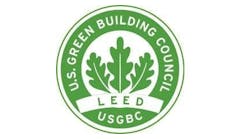Unfortunately for many of us, the roof is out of sight, out of mind – at least until the roof is seriously leaking. Even the most basic maintenance schedule can help extend the life of your roof, however. Consider this sequence as you deal with commercial low-slope roofing issues.
1) The Roofing File: Does It Exist?
The best time to establish a roofing file is during the design phase. The file should contain the areas and buildings covered, specifications and plans, and minutes of any pre-job conferences. Historical information, such as previous surveys and inspections, should be available, as well as previous repairs.
Roof warranty documents should indicate whether the warranties/guaranties are still in effect or have expired. If you have experienced leakage, did you notify the guarantor as required in a timely manner? That would also include notification before installation of new equipment on the existing roof.
2) Inspect From the Top Down
When looking at a roof system, the designer or observer will be looking from the deck (or structural components) upwards.
However, if there is no existing file, we look at what we can see, the surfacing and flashing. For bituminous roof systems, we would be looking at the gravel surfacing, a combination of bitumen (flood coat) and aggregate. Gravel-surfaced roofs are generally limited to a slope of two inches per foot, as otherwise the surfacing could slump downward, leaving felts exposed to UV. An alternative for sloped areas would be to use flashing sheets with factory-applied roofing granules, which are suitable all the way to vertical without slumping. The same would be true for modified bitumen systems, generally with granule surfacing. Other surfacings include field-applied asphalt aluminum roof coatings, emulsion surfacings, or white acrylic paint.
What can roof cuts teach us? If we are trying to fill in the blanks of the missing roof files, we need a contractor to cut holes in the roof, all the way down to the deck. If this will be done by a roof consultant, the consultant will rely on the owner to contract with an experienced roofing contractor (preferably the installer of the original roof) to fill in the holes that same day and to help identify the thermal insulation, number of roof membranes already in place, and roof decking.
Is the existing thermal insulation soaked or disintegrated? Moisture surveys can be very helpful. Infrared, nuclear and capacitance surveys detect symptoms of wet insulation. Taking 12- by 12-inch roof cuts allow the consultant to accurately measure how wet the thermal insulation is and how many layers of membrane and thermal insulation are present. Electronic leak detection (ELD) can detect leakage, even under vegetated roofs.
Richard (Dick) L. Fricklas, received a Lifetime Achievement Award and fellowship from RCI in 2014 in recognition of his contributions to educating three generations of roofing professionals. A researcher, author, journalist, and educator, Fricklas retired as technical director emeritus of the Roofing Industry Educational Institute in 1996. He is co-author of The Manual of Low Slope Roofing Systems (now in its fourth edition) and taught roofing seminars at the University of Wisconsin, in addition to helping develop RCI curricula. His honors include the Outstanding Educator Award from RCI, William C. Cullen Award and Walter C. Voss Award from ASTM, the J. A. Piper Award from NRCA, and the James Q. McCawley Award from the MRCA. Dick holds honorary memberships in both ASTM and RCI Inc.
3) Plan for End-of-Life Issues
Perhaps the key issue is not lacking roofing expertise, but rather the funding for existing roof projects. Many building managers have to work within corporate funding limits, so the above information will help determine whether re-cover is possible or where replacement is necessary.
When one reflects upon death and taxes, the point is eventually reached where repairs no longer keep up with the problems, requiring a roof replacement. This is more complex than it used to be. First of all, building codes have become more rigorous. Your 30-year-old roof may have incorporated R=3 thermal insulation when it was installed, but codes are now looking for R=25 or so. The thicker insulation will require thicker wood nailers at perimeters and curbs and deeper metal edging to cover the nailers. While recycling the roofing products may be desirable, in most cases it is not cost-effective and materials will wind up in a landfill. Some non-adhered components such as roof ballast and interlocking, cement-topped pavers may be the exception. Warranties on thermal performance may even be available if these pavers can be reused. They may also be feasible as a base for solar panels.
Finally, consider obtaining a copy of NRCA, SPRI and ARMA’s joint publication, the Repair Manual for Low-Slope Membrane Roof Systems. This tool can be very helpful to your in-house maintenance staff as they try to prolong an economical roof life.
How to Extend Roof Life
Tips for roof repair and membrane maintenance.
Avoid Roofing Condensation Issues
These situations can lead to costly repairs.
How to Preserve TPO Roofs
8 steps for patching weldable membranes.


